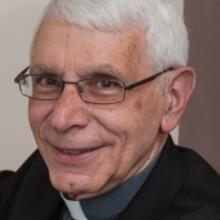Total Self-Gift
His most recent book, Jesus Our Redeemer: A Christian Approach to Salvation, is one of his richest offerings, perhaps because the theme is so central and has close bearing on every other area of theology. Thus O’Collins welds the link with the theology of creation by accenting a “New Adam” Christology; and his adventurous last chapter, “Bodily Resurrection and the Transformation of the World,” shows the bearing of the theology of salvation upon eschatology, the final destiny of humankind and the material universe itself.
A significant and welcome feature of the present work is the author’s sensitivity to the aesthetic. References to poetry and painting, music and film permeate the book. Clearly, they do not represent mere embellishments, but reflect the author’s immersion in art as a mode of theology, as worthy of respect and attention as any of the conceptual Summae Theologiae of the tradition. Even Mel Gibson and the Italian film director Pier Paolo Pasolini make cameo appearances, with the latter being awarded the theological Palme d’Or.
Facile categorizations and contrasts, happily, find no place in O’Collins’s catholic vision. Thus, for example, both Anselm and Abelard receive an appreciative hearing. “Anselm,” O’Collins writes, “laid fresh stress on the humanity and human freedom of Christ, who spontaneously acts as our representative and in no way is to be construed as a penal substitute who passively endured sufferings to appease the anger of a ‘vindictive’ God.” Abelard’s insistence upon love as the key to redemption “shows how salvation is not primarily a ‘process,’ and even less a ‘formula,’ but a person, or rather three persons acting with boundless love.” Both Anselm’s sense of the depth of sin’s dysfunction and Abelard’s sensitivity to the height of redeeming Love provide irreplaceable elements of a comprehensive approach to salvation.
Though alert to criticisms launched against the concept of “sacrifice,” O’Collins rightly underscores its centrality in both Scripture and tradition. He concedes that sacrificial language can be and has been abused; and he affirms, with Aquinas, that suffering as such need not be meritorious. What ultimately counts is Christ’s total self-gift “for our sake.” “Christ made himself vulnerable, and his loving self-sacrifice produced life and growth; this sacrifice brought a renewed communion between human beings and the tripersonal God.” These words call to mind the magnificent 12th-century mosaic of the cross as tree of life in the Church of San Clemente in Rome. Springs of living water flow from the cross and irrigate a flowering acanthus plant. In its branches human beings, birds and beasts all find nourishment: the new creation, fruit of Christ’s loving sacrifice.
Salvation, as Christians distinctively experience and express it, is a Trinitarian mystery. Appropriating Irenaeus’s bold metaphor of Son and Spirit as the “two hands” of God, O’Collins expounds on their inseparable salvific action. In the church’s eucharistic celebration, we re-present the once and for all sacrifice of Christ and invoke the Spirit that we too may be transformed and become Christ’s body. Jesus Our Redeemer manages the difficult task of being Christocentric without slighting the indispensable role of the Holy Spirit in realizing our salvation. Even the vexing issue of the proprium of the Spirit receives suggestive treatment by the association of Spirit with koinonia, communion. “The invisible Spirit works to make the visible Church the place which manifests the divine love, the community which on behalf of all humanity (and the whole cosmos) voices praise and thanksgiving to the Trinity, and which reaches out in loving prayer to all humankind.”
O’Collins offers a considered discussion of an ever more crucial topic: the salvation of non-Christians. On the one hand, he stresses the New Testament’s conviction of the universal salvific significance of Jesus Messiah. On the other hand, he holds that the former covenants, with Noah, Abraham and Moses, are not abrogated. Nevertheless, the Christ event represents a true novum; his resurrection opens to humanity a new and definitive possibility. The paschal mystery brings to full realization what being sons and daughters of God entails: in Christ we are called to become “filii in Filio.”
All grace, abundantly bestowed, bears this paschal imprint. In contrast to some contemporary theologians, but firmly in line with the theology of Karl Rahner, O’Collins teaches that all grace is the grace of Christ, “Any and every acceptance of saving grace and the Holy Spirit, whenever and wherever it takes place, is an acceptance of Christ. There is no zone ‘outside Christ,’ since there is no zone ‘outside’ grace and the Holy Spirit. All experience of salvation is Christological.”
Inspired by the generous “Wisdom theology” of Rahner, O’Collins takes a further systematic step. He closely relates salvation and grace with revelation. In a speculative “coda,” transcribing a theme from the Second Vatican Council, he writes: “the history of revelation is the history of salvation and vice versa.” Symbolically, he associates the two realities with “life” and “light” and sees them as “the two inseparable dimensions of the one divine self-communication.”
While finding much that is stimulating in this view, I would further differentiate the two dimensions of grace and revelation. Thus I take “grace” to be the more ample and inclusive theological category, restricting “revelation” to the explicit articulation of saving grace’s paschal pattern and scope. To put the matter succinctly: while acknowledging that “the history of revelation is the history of salvation,” I am less persuaded of the “vice versa.”
Whatever these reservations with regard to the “coda,” the concerto O’Collins has provided is a splendid performance.
This article also appeared in print, under the headline “Total Self-Gift,” in the October 8, 2007, issue.








